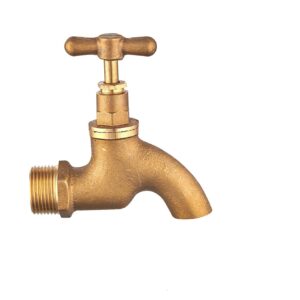Description
Toilet Bibcock Valve
JX-0502
- Brass Toilet Bibcock Valve
- Size 1/2″,3/4″
- Steel handle with plastic cover
- Forged brass with sandblasted
- Max pressure;16 bar
- Temperature;-10-110℃
- ISO228/1 thread.
- Normal brass, CW617N
- Media; Water; Seawater
- This bib cock is an ideal replacement for an outside tap.
- The body of the angled pattern ball bib cock is chrome-plated brass.
- The quarter-turn handle is in place of a regular tee handle, making it easier to operate.
- The spout includes a hose fitting for a standard garden hose.
Installing a new water tap is an easy DIY project that can significantly benefit your home. You’ll also enjoy a more convenient way of getting fresh drinking water from your kitchen sink. This blog post will discuss six steps to help install a new tap in your kitchen sink!
Steps to follow: •Turn off the water supply •Remove any existing faucet parts from beneath the countertop and underneath the sink •Install a flexible hose or steel braided line leading from your main water valve to the location of your new tap •Install a tee, reducing fitting or other connectors to connect the flexible hose with existing faucet lines underneath your sink •Use plumber’s tape when connecting metal parts and then tighten all joints using an adjustable wrench •Turn on water supply and test operation of all parts before replacing any panels or covers that may have been removed during installation.

water tap installation tips:
-turn off the water supply before beginning
-remove any existing faucet parts from beneath the countertop and sink
-install a flexible hose or steel braided line leading from your main water valve to the location of your new tap
-use plumber’s tape when connecting metal joints and tighten all using an adjustable wrench
-turn on the water supply and test the operation of all parts before replacing any panels or covers removed during installation.

Do you need to replace your kitchen faucet? Here are five steps that will help make the process a lot easier.
1. Turn off the water supply by turning the valve on your plumbing system.
2. Remove any attachments under the sink, such as filters or valves attached with nuts and bolts to the pipes.
3. Disconnect any hoses connected to your faucet or sprayer handle with a pair of pliers and set them aside for now.
4. Using a wrench, remove any hex-head connections at either end of your faucet’s supply lines that may be in place, then unscrew it from its mounting bracket using an adjustable wrench.
If your faucet doesn’t have supply lines, you’ll need to remove the entire unit by unscrewing it from the sink.
Be very careful when removing old faucets, as they may be brittle and prone to breaking.
Toilet Bibcock Valve
A toilet bibcock valve is an essential plumbing equipment that provides a reliable water supply to the toilet. It works by regulating the flow of water into and out of the tank and is usually located just below the rim or bowl of the toilet. This small yet important valve is designed for maximum performance and helps you save on energy waste by ensuring a consistent flow rate into your toilet.
The most common toilet bibcock valve type is brass or stainless steel. It features a lever handle that allows you to adjust the water pressure entering your tank while also providing protection against accidental over-filling and flooding. Additionally, these valves are often equipped with anti-siphon mechanisms which prevent backflow contamination, making them ideal for potable water systems. With regular maintenance, these valves should last for many years without needing replacement.
What is a Toilet Bibcock?
A toilet bibcock valve is an essential part of the plumbing system in any home. It controls water flow from the main water supply line to a toilet tank. The valve is usually brass and consists of two parts, a body that threads onto the water line and a handle that opens and shuts off the water flow.
The purpose of a toilet bibcock valve is to regulate how much water flows into the tank so that it does not overflow or get too low for proper flushing. It also helps protect against backflow, which can contaminate your home’s drinking water supply with wastewater from toilets or drains. Installing a toilet bibcock valve can help ensure plumbing safety and efficiency in your home and reduce potential damage caused by overflowing tanks or inconsistent flushing performance.
How Does It Work?
When it comes to the functioning of a toilet, understanding how a bibcock valve works is essential. A toilet bibcock valve is an important part of the plumbing system in a bathroom and helps control water flow to the fixture. This type of valve consists of two valves: one for hot water and one for cold water. Combining these two valves allows you to control water temperature and pressure to ensure your toilet functions properly.
The first step in understanding how a bibcock valve works know its purpose. The main function of this valve is to regulate the amount of hot and cold water that enters your toilet bowl when you flush it. When you press down on the handle, it opens up both valves to let enough hot and cold water in so that your toilet flushes as expected.






